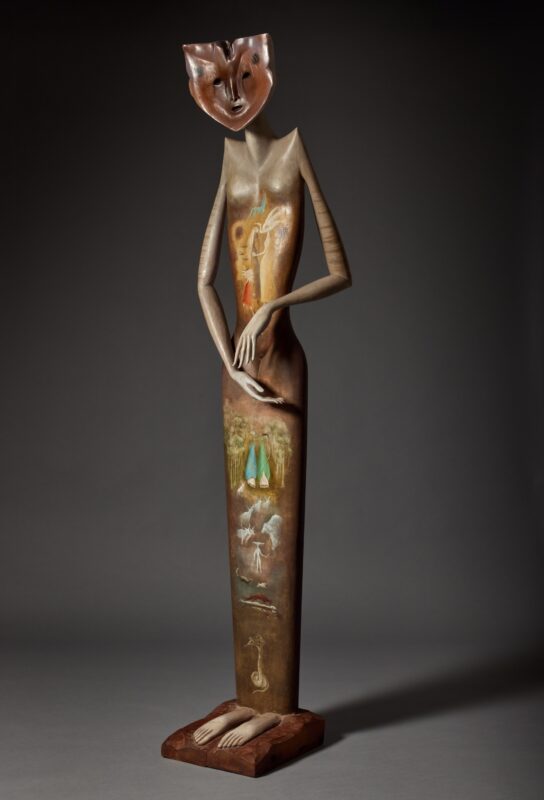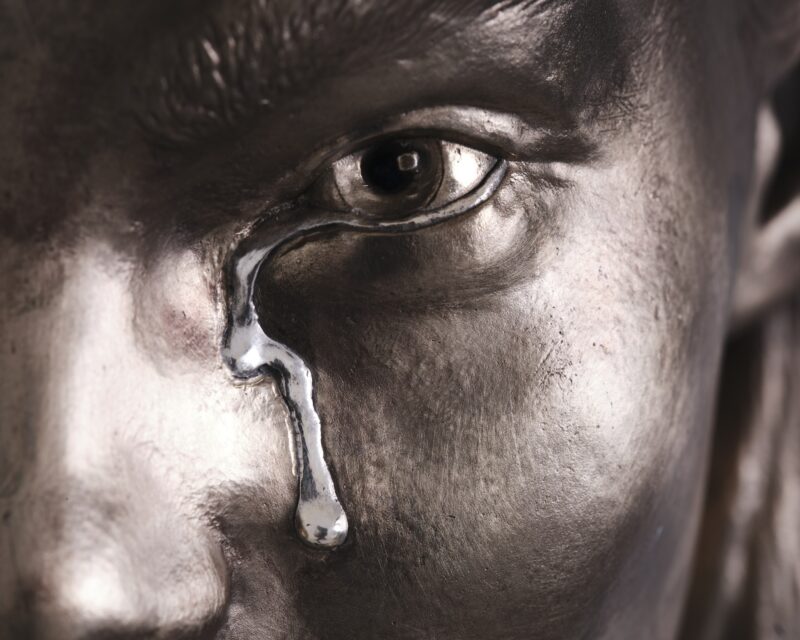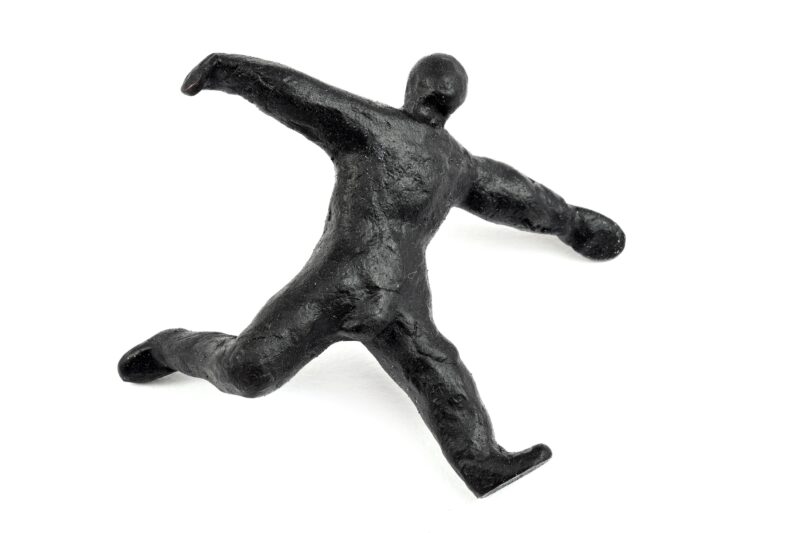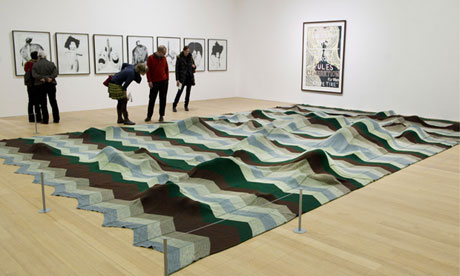
Designed to tease … Mike Kelley’s Lumpenprole (1991) on display at the Stedelijk Museum, Amsterdam. Photograph: Evert Elzinga/AFP/Getty
What is hidden under the big Afghan blanket on the floor? Those bulges tease the imagination. Nearby, grubby old knitted dolls and stuffed plush animals sit around holding conversations. I hear animal noises. So what’s going on under the blanket, in Mike Kelley’s 1991 Lumpenprole – are they humping? What muffled whispers do they share, what furtive games are they playing?
This is a children’s game played by an adult – the artist at work. The Lumpenprole of the title won’t grow up, or rather, the play he is indulging in has been consciously dragged too far into adulthood. At the same time, it is a very conscious play on floor-bound sculpture; a refusal of the normative. This seems to be the message, and it’s a message as much about Kelley’s working-class Catholic upbringing in the Detroit suburbs as about his own refusals to conform to gender stereotypes and parental expectations in his youth.
Here is an awkward, acne-scarred boy who played with dolls, wore nail varnish and his hair long, was bullied, bunked off and smoked drugs in the mall, played in a band, went to local art school, ended up at CalArts and went on to become one of LA’s – and America’s – leading artists.
Kelley’s early work was a riposte to the kind of successful 1980s art that revelled in its market-friendliness. But poor art, as well as slick art, comes and goes: art and the market are full of traps. Much of Kelley’s awkwardness and recalcitrance – let alone his intelligence and humour – was about resisting the packaging and easy assimilation of the market. He tried to stay a moving target, ahead of the game.
Kelley never did learn to conform. Childhood and repressed memories, adolescent rites, traumas and fears fill Kelley’s retrospective, which opened at Amsterdam’s Stedelijk Museum last weekend. It crowds the museum’s new extension. Kelley’s work occupies two new suites of windowless galleries, in the basement and on the first floor. The exhibition admits no daylight; this feels apt. Kelley’s art somehow always demands a bunker or cave, basements and spooky places. There is a sense of siege. There’s too much to take in on a single visit. You feel as if his whole life is here, in room after room of works, hour after hour of film and video, installation after installation, if only you could unravel it. As it is, Kelley’s life came undone by depression and he killed himself, at the age of 57, in January 2012.
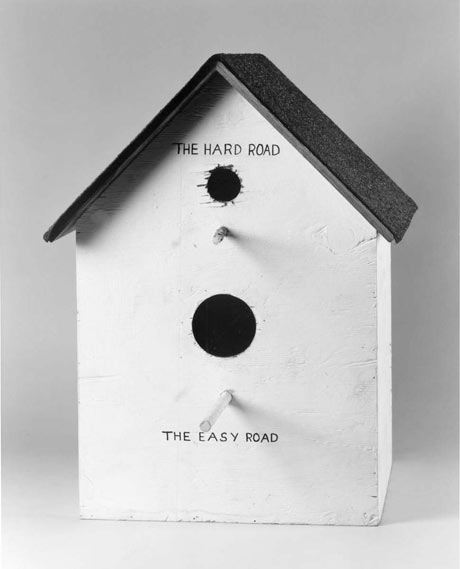
Planned over several years as a mid-career survey show, this is now a retrospective. It is impossible not to look at his art without reading the artist’s psyche through it. Much of Kelley’s work was not just informed by autobiography, but made overt use of it. His art had a complex relationship to his life, which he used as both material and subject – whether he was reinventing his childhood in the long, unfinishable series of video and sculptural installations Day is Done (he planned an unmanageable, 365 interconnected installations, only 32 of which were completed in 2004-05), making works based on found high-school yearbooks, or constructing huge tabletop models of the house he grew up in and every educational establishment he ever attended. Kelley’s 1995 Educational Complex is an all-white, bleached-out territory of halls and corridors, changing rooms, studios and classrooms. It incorporates misremembered details with emptiness, registering what he has forgotten or repressed. The model marks time as much as space and place. Peering over it, the model seems endless, measured in decades rather than physical space. There’s even a mattress under the table, so you can lie and look up at the underside of the building. This sub-level is more than a place; it’s a mental state.
In the sculpture and video works Day is Done, we are plunged into a world of re-enacted childhood scenes, including nativity plays and one uncomfortable scene set in a barber shop, where a boy is teased about his long hair and frightened by leering barbers. “Do you wanna shave, kid?” Another customer smokes, his bearded mouth sucking lewdly on his pipe. The entire scene is sexualised and stomach-churningly unpleasant, with its innuendoes, bullying and references to the bathroom, which is built into the installation beside the screen. At a certain point, the devil makes an appearance on a second screen. Kelley loses me at this point, and the whole thing tips over into a kind of burlesque.
Later, watching a screening of filmed performances and other videos, I come across Kelley himself as the devil, naked and writhing on a bridge at night, some sort of teenage rite. Then, somehow, a whole world is conjured in a toilet bowl, frothy continents and archipelagos formed in a stream of piss by a malevolent god. We’re flushed away with it, ending up back at the bridge.
And here’s an actor playing Superman, reading from Sylvia Plath’s The Bell Jar. Superman, and his city of Kandor, itself kept under glass, became a major theme in Kelley’s work over the past decade. I found this – with its Hammer Horror S&M-lite and its conflation of Superman and Gabriel Dante Rossetti – an overwrought project when I reviewed it.
Kelley, like most artists, had problems with critics. “Artist and critic are dependent on each other but have fundamentally different social positions and world views,” he told an interviewer in 2003. “As the story goes, the artist is uneducated but has a kind of innate gift for visual expression, which the educated and socialised critic must decode for the general population. The pathetic symbiotic relationship of this odd couple is endlessly amusing,” he said.
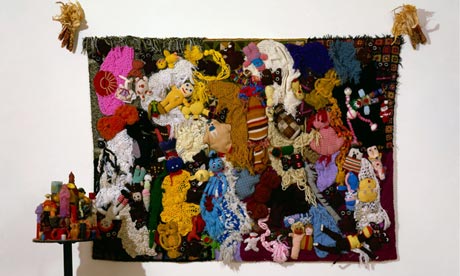
Decoding isn’t always viable, or even necessary. Not all of what Kelley did is easily read. His art consciously offers resistance, and his own commentaries make matters even murkier. But Kelley liked murk. The preposterously titled video play Extracurricular Activity Projective Reconstruction #1 (Domestic Scene), 2000, is about two men living in a seedy room whose centrepiece is a gas stove. Kelley developed the entire one-act scene from a still he found of a high school performance, and extrapolated the play from this single image. Kelley’s play is as appalling and bleak as it is funny. The dominant man wheedles the other, an unfortunate street person, into putting his head in the oven. How could a performance be both so over-the-top and so nearly believable? I went a bit mad watching it. I’d last seen this almost a decade ago, and its rancid humour had hung around in my head ever since.
At his best, Kelley is as direct as he can be obtruse. In this exhibition, I kept losing the plot as well as my way, only to be brought up short by an incident in a video, or an object, a drawing or moment that thrills me, upsets me, makes me wince. Kelley at his best had real edge, whether he was knocking up ludicrous bird boxes, working with a cast of abject soft toys, making horrible scatological drawings or painting a series of shemales which he called Naked Majas after Goya. His art was parodic and painful, full of embarrassment. Maybe it’s too soon for a full-on retrospective. Instead we seem to end up with a show of examples of Kelley’s work rather than one that brings out his best, or most essential. Maybe we are too close properly to address his uneven trajectory – though retrospectives have a kind of duty to chart more than the highpoints. But right now, it’s the best one we have.
guardian.co.uk © Guardian News & Media Limited 2010
Published via the Guardian News Feed plugin for WordPress.
